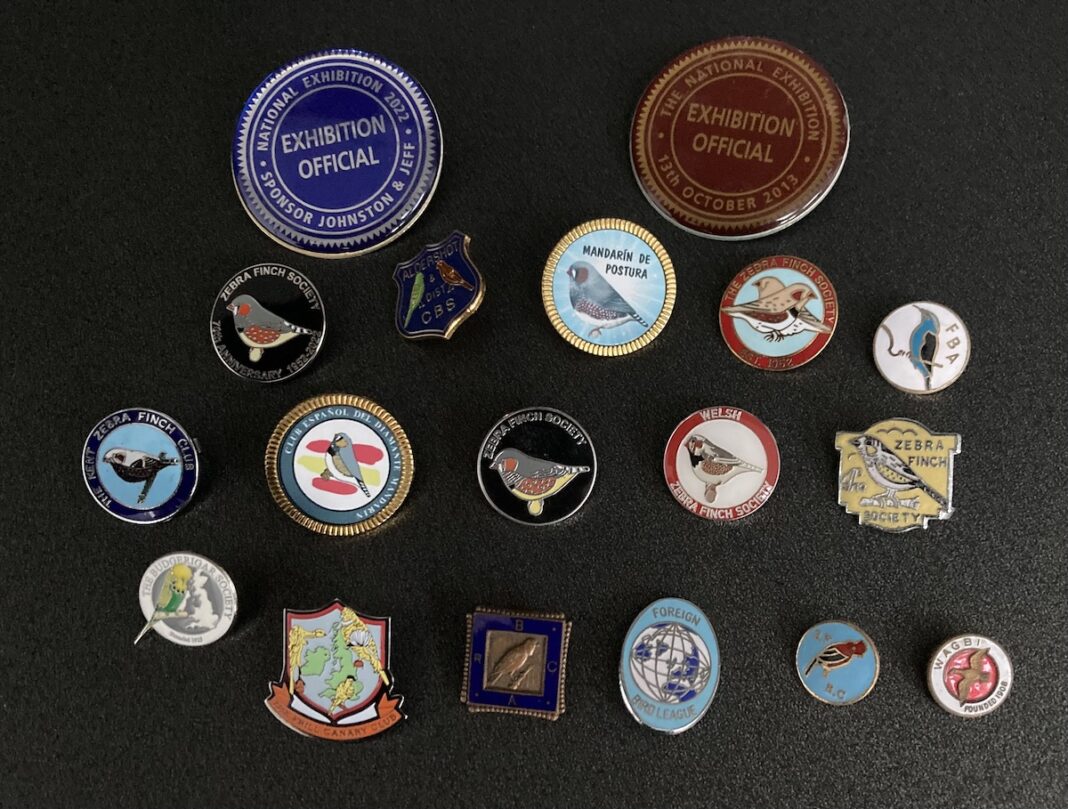Love birds? Love old bird books? Trouble is, they take up space. Happiness, says DAVE BROWN, is a compact collection of rare pin badges. Or stamps. Or National catalogues. Or…
IN A recent conversation with the world-renowned budgerigar breeder Ali Bouresli, of Kuwait, we got on to the topic of collections. Not collections of birds, as you might imagine: fanciers who aim to produce quality birds and achieve consistent show success should forget any idea of a “collection” and build a stud. No, in fact the collections in question were comprised of bird-related pin badges.
Ali had started hunting out budgerigar-themed pin badges and it turned out that I had a small collection of mainly zebra finch-related badges, too. Collecting is a long-established tradition in the fancy and, for the birdkeeper, creating a bird-themed collection of some type can add an extra layer to your hobby. With items such as badges, most usually they denote a specialist club or large show and they can be built into a colour album of bird-keeping history as clubs come and go over time.
The other advantage of badges is that they don’t take up very much space. So a decent collection is probably not going to cause too much domestic strife compared – say – with a collection of jukeboxes. (I have a friend who is into this and the possession of multiple machines in multiple rooms may have been a factor in his recent divorce.)
Perhaps, just as in bird breeding, it is often best to specialise when you are building a collection. For years, I have been a sucker for picking up old birdkeeping books. However, without a specialism the numbers grow and even though they weren’t in juke-box territory I found it easy to end up keeping books in boxes and not on display. Note: despite the impression I am probably creating, I am certainly not a hoarder, and many of these books have now been passed on. Those I have retained need to be – in my opinion – significant in avicultural history (examples would include The Cult of the Budgerigar by Bill Watmough or The Challenge by Gerald Binks), or shed light on birdkeeping in much earlier times (Bechstein’s Cage Birds and Sweet Warblers – of which the first edition was circulating in the 1790s – or Wallace’s The Canary Book from the 1800s).
Another strand to this is trying to obtain copies of the catalogue from old National Exhibitions. It’s a bit like collecting football programmes, I suppose. I have a collection that gives details of the entry at shows at Crystal Palace, Olympia, Alexandra Place and the NEC. It is fascinating to study how birds and entries have evolved over the years. Take zebra finches, for example. Their evolution has seen a class or two in the foreign bird section grown into a specialist section, where initially several mutations were grouped together. However, as a bird’s popularity and the number of its mutations grew, so did classes for each of these mutations. With budgerigars, for instance, in 1936 the light yellow cock class had an entry of 47: pretty impressive.
Consider the spoon!
The collecting of books always means that it is hard to avoid popping into a book shop when we are out and about visiting different places. And of course this adds a little bit of extra interest.
Incidentally, an advert in the 1936 National Exhibition catalogue announced that commemorative spoons would be awarded. Perhaps that is another line that a fancier looking to collect something might consider.
Collecting stamps, of course, is a mainstream hobby and there are plenty of bird-themed stamps to be found covering numerous countries and periods of time. A great set to start with for a birdkeeper is the Isle of Man “show bird” collection, created over the past few years using the photography by Luke Stephenson. The Manx set features budgerigars and Gouldian finches, amongst others. Cigarette cards are another option: Players created a series of cards themed around aviary birds – and of course if you want something to hang on the wall there are any number of old prints to be sought out and bid for.
When it comes to the collecting lark, the choice is wide. Just avoid anything that takes your money and plays a wobbly series of hit songs from the 1950s! ■
Find more news and articles like this on the Cage & Aviary Birds website. Subscribe to Cage & Aviary Birds magazine now.


